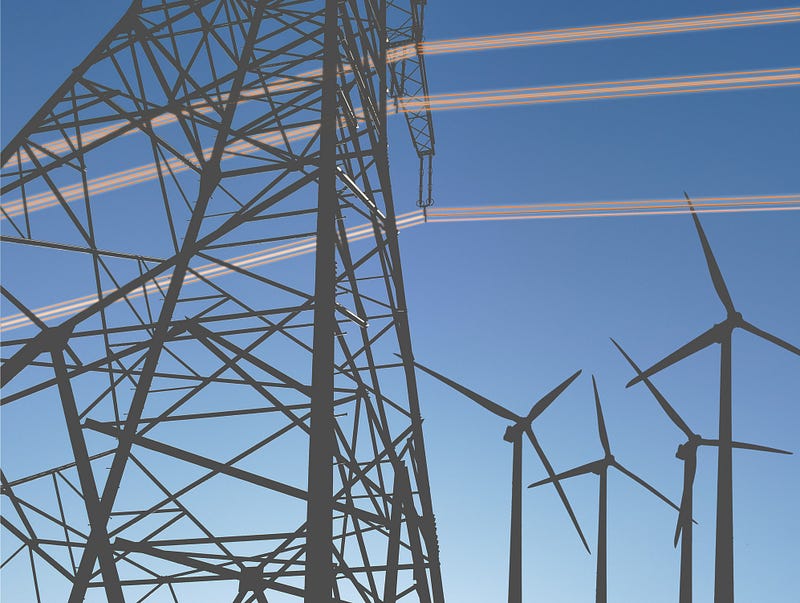To Avoid a Repeat of Blackouts, Researcher Suggests Diversifying
Thousands of Californians suffered blackouts this fall, but research offers steps for utilities to prevent similar outages in the future.
Based on the research of Stathis Tompaidis

In October and November, more than 800,000 Californians lost power, when Pacific Gas & Electric turned off transmission lines to prevent wildfires. In 2011, 54 Japanese nuclear plants were closed, after a tsunami caused three of them to melt down. These two events had something in common, says Stathis Tompaidis, professor of Information, Risk, and Operations Management at Texas McCombs. They were dependent outages: several units going down at the same time, from the same root cause, due to being interconnected.
Electric grids are frequently set up in ways that lead to interconnected shutdowns. The result, as Californians learned, is that grids are not as reliable as they think.
In a new paper, Tompaidis and his co-authors — Vishwakant Malladi from the Indian School of Business and Rafael Mendoza-Arriaga from discretionary fund manager Man GLG — measured the odds of electric grids suffering simultaneous outages. Through the use of more diverse fuel sources and incentives, massive blackouts — like the ones in California — could be prevented.
Shared transmission lines are one source of dependent outages. Are there other kinds of dangerous linkages?
Many power plants have the same kind of input fuel. In Japan, when a tsunami shut off a few nuclear power plants, they closed down all the nuclear plants in the country. It affected the entire national grid.
Think about Texas and the Northeast where pipelines are used to deliver natural gas to power plants. Occasionally those pipelines freeze. When they can’t get natural gas, they don’t run. Or take hydroelectric power on the West Coast. It’s associated with the amount of rain that falls. Those plants empty at similar rates, and they end up going out together.
How do you model the chances that several plants will shut down jointly?
We think of each plant as belonging to several different but overlapping groups. Take a natural gas plant in Central Texas. It’s in one group with all other natural gas plants. It’s in a second group of all the power plants in Central Texas. It’s also in a third group, based on what kind of transmission line it’s on.
Within each group, we captured historical outages. How often do five of them go down at the same time? How often do six go down? In ERCOT [the grid that covers most of Texas], between 2008 and 2012, there were 14 outages of seven or more plants. Once we matched the model to those data, we could predict what rates of simultaneous outages we should see.
So what’s the solution?
If we’re installing new power sources that are likely to go down simultaneously, they’re not going to help us in the case of a blackout. We need diversity in our capacity. That’s why we need to know, for each region, which kinds of plants are prone to dependent outages. In Texas, it was natural gas plants. In the Western Electric Coordinating Council, which covers 14 states, it was also plants that use hydroelectric energy, distillate oil, and geothermal energy.
You didn’t have data on wind or solar. Are they vulnerable, too?
As we start integrating renewable resources to the grid, dependent outages will become even more important. Solar and wind have a large dependence on location and the weather conditions in those locations. That’s going to mean large swings in supply. Will we need certain amounts of conventional generation to manage those swings? Will we use batteries instead? These are questions we really need to understand.
To get a blackout-resistant power mix, how can we encourage operators to build other types of power plants, which aren’t prone to joint shutdowns?
We can incorporate those needs into price incentives. A plant with one type of fuel could get some kind of bonus, because they need more of it. Another kind of plant might get some kind of penalty, because it doesn’t add to the grid’s reliability.
Or, if the form of power they’re selling is not as reliable as they’d like, the seller might need to promise reserves in a different technology. To get a contract for your solar plant, they might have to couple it with a certain amount of battery storage or natural gas backup.
You say your model doesn’t just apply to electric plants. How else could it be used?
The same idea works with wireless cell towers. They may overlap in places, so that if one goes out, you don’t lose a signal. But if a bunch of them go down simultaneously, you have a problem.
It doesn’t just apply to physical networks. Our methodology was originally developed for modeling joint defaults on corporate debt. In the 2008 financial crisis, multiple firms faced problems coming from the same sources. So, in a particular region, you’d have one default, but it turned into five defaults. A model like this helps to capture that kind of dependence.
“Modeling Dependent Outages of Electric Power Plants” published online Dec. 11 in Operations Research.
Story by Steve Brooks


